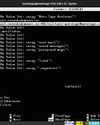FAST VIRTUAL MACHINES
Linux Format
|August 2022
Jonni Bidwell transcends meat space, ventures virtuously into the valleys of the virtual and returns laden with actual knowledge.

Virtualisation… where would we be without it? We don’t actually know, but life would certainly be harder. Thanks to virtual machines (VMs), home users can effortlessly boot all manner of other operating systems. Those might be exotic flavours of Linux or (since you surely don’t really need an actual install of this monstrosity anymore) a Windows VM for those odd times where it’s handy. This can be taken to extremes, too. Thanks to PCIe passthrough, which we covered back in LXF273, you can sacrifice a whole GPU to your VM, enabling it to run games (or CUDA simulations) arbitrarily close to native speed.
This time around we’ll look at a different but equally impressive technology in the form of Intel GVT-g. This makes it possible for us to segment newer Intel GPUs into virtual ones that can be seamlessly connected to our VMs. Unlike the passthrough method, this still enables us to use the GPU on the host.
Businesses, too, have a lot of love for the virtuals. VMs are highly portable and much easier to re-instantiate than regular machines in the event that the host running them catches fire. There’s also an efficiency improvement, in that a single machine can take on the role of several servers, and still enjoy the benefits of having those workloads properly segregated. Containers, of course, achieve this with even more efficiency, but at the cost of losing some of that segregation.
There are all kinds of tools for managing virtual machines at scale, so we’ll have a brief look at one of those, too. Specifically, we’ll show you that Vagrant makes it trivially easy to install Arch Linux.
Denne historien er fra August 2022-utgaven av Linux Format.
Abonner på Magzter GOLD for å få tilgang til tusenvis av kuraterte premiumhistorier og over 9000 magasiner og aviser.
Allerede abonnent? Logg på
FLERE HISTORIER FRA Linux Format

Linux Format
Create your first WebSocket service
Mihalis Tsoukalos explains how to use the Go programming language to work with the WebSocket protocol.
9 mins
April 2023

Linux Format
Fantastic Mr Firefox
Nick Peers takes a trip down memory lane to reveal the story behind the rise - and slight fall - of Mozilla's popular web browser.
9 mins
April 2023

Linux Format
Set up your terminal and email like it's 1983
Jump in the hot terminal time machine with Mats Tage Axelsson who emails from the command line using the latest technology.
8 mins
April 2023

Linux Format
Universal layer text effects with GIMP
Posters use them, films and presentations are hard to imagine without them: text effects. Attract attention with Karsten Günther and GIMP.
8 mins
April 2023

Linux Format
Jump to a federated social network
Nick Peers reveals how you can get up and running with this free, decentralised and non-profit alternative to Twitter.
9 mins
April 2023

Linux Format
Free our SOFTWARE!
Taking anything for granted is dangerous, so Jonni Bidwell and Mike Saunders revisit how the free software movement got started to help free us from proprietary tyranny!
4 mins
April 2023

Linux Format
Master RPI.GPIO
Les Pounder goes back to the early days of the Raspberry Pi - and his career with this classic library! -
5 mins
April 2023

Linux Format
Waveshare Zero to Pi3
Transform your Pi Zero into a Pi 3, they promised Les Pounder, but it's more like adding on go-faster stripes.
2 mins
April 2023

Linux Format
The Best OPEN SOURCE Software Ever!
In an attempt to trigger controversy, Michael Reed and Neil Mohr unequivocally state these are the greatest free software apps ever. Probably. We’re just trying to be helpful.
19 mins
April 2023

Linux Format
Linux-Mandrake 7
Simplicity and a wide range of applications make this a great distribution for all Linux users.
2 mins
April 2023
Translate
Change font size

